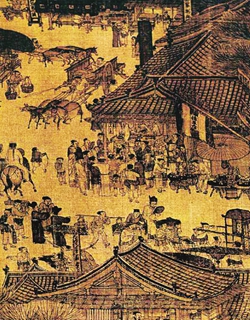Chinese Architecture
Cai Yanxin
Capital Construction After the founding of a dynasty, great emphasis was given to selection of the capital location. Trusted ministers were often dispatched to survey landforms and the hydrographic situation and take charge of construction. The primary factor considered in selection of the capital location was of course the rulers' political and military needs.
The issue of water sources was also very important. Drinking water was most important, followed by water for gardens and water for canal transportation. Canals were lines of grain and material supplies to the capital. We can almost call them lifelines of all dynasties.
In ancient China, The Doctrine of the Mean was advocated, and attention was paid to the "center" in both city construction and capital construction.
The capital of the Zhou Dynasty was planned orderly with three city gates on each side and the imperial palace at the center. It became the standard of Chinese ancient capital planning and construction.
To protect rulers' safety, from the Spring and Autumn Period (770-476 BC) to the Ming (1368-1644) and Qing (1644-1911) dynasties, the inner city and outer city were set up in the capital.
As the saying goes, "The inner city is built to protect the emperor, and the outer city is built to guard people."
A capital usually had three layers of city walls: The imperial palace, the imperial city or inner city, and the outer city. Some even had four layers.
Ancient rulers thus protected their safety through multiple layers of walls.

Cai Yanxin
Capital Construction After the founding of a dynasty, great emphasis was given to selection of the capital location. Trusted ministers were often dispatched to survey landforms and the hydrographic situation and take charge of construction. The primary factor considered in selection of the capital location was of course the rulers' political and military needs.
The issue of water sources was also very important. Drinking water was most important, followed by water for gardens and water for canal transportation. Canals were lines of grain and material supplies to the capital. We can almost call them lifelines of all dynasties.
In ancient China, The Doctrine of the Mean was advocated, and attention was paid to the "center" in both city construction and capital construction.
The capital of the Zhou Dynasty was planned orderly with three city gates on each side and the imperial palace at the center. It became the standard of Chinese ancient capital planning and construction.
To protect rulers' safety, from the Spring and Autumn Period (770-476 BC) to the Ming (1368-1644) and Qing (1644-1911) dynasties, the inner city and outer city were set up in the capital.
As the saying goes, "The inner city is built to protect the emperor, and the outer city is built to guard people."
A capital usually had three layers of city walls: The imperial palace, the imperial city or inner city, and the outer city. Some even had four layers.
Ancient rulers thus protected their safety through multiple layers of walls.

Part of Along the River During the Qingming Festival by Zhang Zeduan in the Northern Song Dynasty (960-1127) Photo: Courtesy of the China Intercontinental Press

